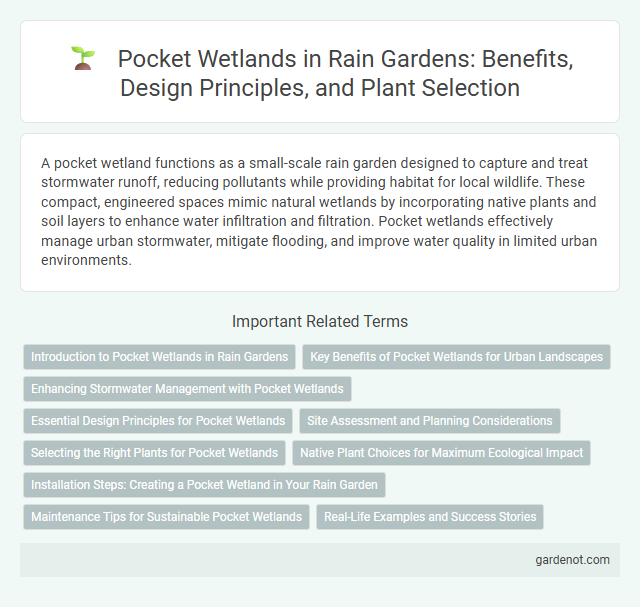A pocket wetland functions as a small-scale rain garden designed to capture and treat stormwater runoff, reducing pollutants while providing habitat for local wildlife. These compact, engineered spaces mimic natural wetlands by incorporating native plants and soil layers to enhance water infiltration and filtration. Pocket wetlands effectively manage urban stormwater, mitigate flooding, and improve water quality in limited urban environments.
Introduction to Pocket Wetlands in Rain Gardens
Pocket wetlands in rain gardens create small, engineered depressions designed to capture and filter stormwater runoff. These compact, vegetated areas mimic natural wetland functions by promoting water infiltration, nutrient uptake, and pollutant removal. Integrating pocket wetlands enhances urban stormwater management by reducing runoff volume and improving water quality.
Key Benefits of Pocket Wetlands for Urban Landscapes
Pocket wetlands enhance urban landscapes by effectively managing stormwater runoff, reducing flooding risks, and improving water quality through natural filtration processes. They provide critical habitats for local wildlife, promoting biodiversity in densely populated areas. These compact ecosystems also contribute to cooling urban heat islands and offer aesthetic and recreational value to communities.
Enhancing Stormwater Management with Pocket Wetlands
Pocket wetlands serve as compact, highly effective stormwater management systems that naturally filter pollutants and reduce runoff volume. By mimicking natural wetland processes, these engineered ecosystems enhance groundwater recharge and improve water quality in urban areas. Incorporating native plants and microorganisms within pocket wetlands supports biodiversity while mitigating flooding and erosion.
Essential Design Principles for Pocket Wetlands
Pocket wetlands require careful attention to hydrologic conditions, including proper site selection with appropriate water source inputs and controlled flow rates to mimic natural wetland hydrology. Soil composition must support both water retention and adequate drainage, often involving layered substrates with sand, clay, and organic material to optimize nutrient cycling and pollutant removal. Native vegetation adapted to periodic inundation enhances biodiversity and water filtration, while incorporating features such as varied microtopography promotes habitat diversity and effective water treatment.
Site Assessment and Planning Considerations
Site assessment for pocket wetlands involves analyzing soil permeability, existing vegetation, and hydrology to ensure proper water retention and filtration. Planning considerations include selecting a location with sufficient sunlight, minimizing disturbance to native habitats, and designing inlet and outlet structures to manage stormwater flow effectively. Proper evaluation of topography and water sources helps optimize pollutant removal and supports sustainable wetland function.
Selecting the Right Plants for Pocket Wetlands
Selecting the right plants for pocket wetlands is crucial for maximizing water filtration and supporting local biodiversity. Native wetland species such as cattails, sedges, and rushes thrive in saturated soils while providing habitat for amphibians and pollinators. Incorporating diverse root structures enhances soil stabilization and improves nutrient uptake, ensuring long-term pocket wetland functionality.
Native Plant Choices for Maximum Ecological Impact
Selecting native plants such as yellow coneflower, blue flag iris, and cardinal flower enhances the ecological function of pocket wetlands by attracting pollinators and improving water filtration. Deep-rooted species like switchgrass and sedges stabilize soil and support microbial communities essential for nutrient cycling. Incorporating diverse native vegetation maximizes habitat complexity, promoting biodiversity and resilience in these engineered wetland systems.
Installation Steps: Creating a Pocket Wetland in Your Rain Garden
To create a pocket wetland in your rain garden, begin by selecting a low-lying area that naturally collects runoff and excavate a shallow depression approximately 6 to 12 inches deep. Install an impermeable liner or compacted clay layer to retain water, then add a 4- to 6-inch layer of gravel or sand for drainage and habitat support. Finish by planting native wetland vegetation, such as sedges, rushes, and moisture-tolerant perennials, to enhance water filtration and provide wildlife habitat.
Maintenance Tips for Sustainable Pocket Wetlands
Regular inspection of pocket wetlands ensures early detection of sediment buildup and invasive species, maintaining water quality and habitat health. Seasonal pruning of native plants promotes vigorous growth and optimal pollutant filtration. Proper debris removal and sediment management prevent clogging and extend the functional lifespan of the pocket wetland system.
Real-Life Examples and Success Stories
Pocket wetlands have demonstrated effective stormwater management in urban settings, such as the Anacostia Watershed in Washington, D.C., where these installations have reduced runoff pollution by 40%. In Minneapolis, a network of pocket wetlands has improved local biodiversity, attracting native bird species and amphibians. Success stories include increased groundwater recharge and enhanced neighborhood aesthetics, proving the viability of pocket wetlands as sustainable green infrastructure.
Pocket wetland Infographic

 gardenot.com
gardenot.com